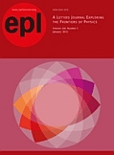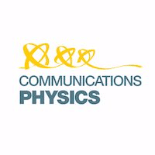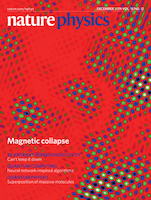
Lithuanian Journal of Physics
Scope & Guideline
Empowering Discoveries in Physics and Astronomy
Introduction
Aims and Scopes
- Theoretical and Computational Physics:
Research focusing on theoretical frameworks, models, and computational methods to solve complex physical problems, including quantum mechanics, statistical mechanics, and thermodynamics. - Materials Science and Engineering:
Studies on the synthesis, characterization, and application of novel materials, including semiconductors, nanomaterials, and thin films, often involving advanced fabrication techniques. - Optics and Photonics:
Exploration of light-matter interactions, optical properties of materials, and development of photonic devices such as lasers, detectors, and imaging systems. - Condensed Matter Physics:
Investigations into the properties of solid and liquid matter, including phase transitions, magnetic properties, and electronic structures. - Applied Physics and Engineering:
Application of physical principles to solve practical problems in engineering, including the development of new technologies and devices. - Interdisciplinary Studies:
Integration of physics with other scientific disciplines, such as biology or environmental science, to address complex scientific questions.
Trending and Emerging
- Terahertz Science and Technology:
An increasing number of studies focus on terahertz (THz) applications, including imaging and spectroscopy, reflecting the growing interest in THz technologies for various applications in communication, security, and medical diagnostics. - Nanotechnology and Nanomaterials:
Research on the properties and applications of nanomaterials has surged, indicating a strong trend towards exploring their unique physical characteristics and potential uses in electronics, photonics, and materials science. - Quantum Computing and Information Science:
Theoretical and experimental investigations into quantum computing, including qubit systems and quantum information processing, have gained momentum, highlighting the journal's engagement with cutting-edge technologies. - Advanced Laser Technology and Applications:
A notable rise in studies examining advanced laser systems and their applications in various fields, including medical technologies and materials processing, reflects ongoing innovations in laser physics. - Multiscale Modeling Techniques:
Increasingly, researchers are employing multiscale modeling approaches to understand complex physical systems, indicating a trend towards integrating different scales of analysis in physics research.
Declining or Waning
- Classical Mechanics:
Research related to classical mechanics, including foundational theories and applications, has seen a reduction in publication frequency, possibly due to the growing emphasis on quantum mechanics and advanced computational models. - Traditional Material Characterization Techniques:
Studies focused on conventional characterization methods, such as basic spectroscopy or standard thermal analysis, have become less common as researchers adopt more sophisticated techniques that provide deeper insights into material properties. - Environmental Physics:
While still relevant, research specifically addressing environmental physics topics, such as basic pollution studies, appears to be less frequent, possibly overshadowed by interdisciplinary approaches that incorporate environmental concerns into broader physics research. - Historical Perspectives in Physics:
Papers providing historical analyses or philosophical discussions regarding physics concepts are less common, reflecting a trend towards more empirical and application-driven research.
Similar Journals

INDIAN JOURNAL OF PHYSICS
Bridging Theoretical Insights and Experimental DiscoveriesINDIAN JOURNAL OF PHYSICS, published by the Indian Association for Cultivation of Science, serves as a pivotal platform for researchers and scholars in the field of physics and astronomy. With its ISSN 0973-1458 and E-ISSN 0974-9845, this journal is committed to presenting innovative research and developments across diverse topics in physics, covering both theoretical and experimental studies. The journal has made its mark in the academic community, evidenced by its classification in the Q3 category within the Physics and Astronomy domain as of 2023, and ranks #100 out of 243 in the Scopus curated database, placing it in the 59th percentile. Spanning from 2005 to 2024, the INDIAN JOURNAL OF PHYSICS aims to foster knowledge exchange and stimulate discussions among physicists and scientific enthusiasts. Whether you are a researcher looking to publish your findings, a professional seeking updates in your field, or a student eager to explore varying aspects of physics, this journal is an invaluable resource contributing significantly to the understanding and advancement of physics in India and beyond.

EPL
Connecting Minds, Inspiring Breakthroughs in AstronomyEPL, a prominent journal published by IOP Publishing Ltd, stands at the forefront of the field of Physics and Astronomy. With a history of impactful contributions stretching from 1986 to 2024, EPL serves as a dynamic platform for researchers to disseminate their pioneering findings and innovative ideas. The journal, with a current category ranking of Q2 among its peers and a competitive Scopus rank of #101 out of 243 in the general physics and astronomy category, reflects its substantial reputation and contribution to the scientific community. Although it operates under a traditional subscription model, EPL's reach is extensive, enabling access to a diverse readership that includes academicians, industry professionals, and students alike. By fostering interdisciplinary collaboration and promoting rigorous research, EPL continues to play a vital role in shaping the future of physics and astronomy.

Communications Physics
Fostering dialogue among the brightest minds in physics.Communications Physics is a premier open access journal published by Nature Portfolio, dedicated to disseminating high-quality research in the field of Physics and Astronomy. Since its inception in 2018, the journal has rapidly established itself as a vital platform for innovative scientific communication, boasting an impressive Impact Factor and achieving Q1 status in the 2023 category of Physics and Astronomy (miscellaneous). With a Scopus rank of #31 out of 243, placing it within the 87th percentile, Communications Physics attracts a global audience of researchers, professionals, and students eager to engage with cutting-edge findings. The journal supports open access, ensuring that research is freely available to the public, which enhances its visibility and encourages broader discussions within the scientific community. Located in Berlin, Germany, Communications Physics aims to bridge the gap between various disciplines within physics, fostering interdisciplinary collaboration and inspiring future research endeavors.

Physical Review Research
Connecting minds through groundbreaking research.Physical Review Research, published by the American Physical Society, is a premier open access journal dedicated to the dissemination of high-quality research across all areas of physics and astronomy. Since its inception in 2019, this journal has quickly established itself as a vital platform for researchers, achieving a prestigious Q1 ranking in the dynamics of Physics and Astronomy (miscellaneous) and holding a commendable position in the Scopus Rankings with a rank of #29 out of 243, placing it in the 88th percentile. With the commitment to fostering scientific collaboration and transparency, Physical Review Research offers unrestricted access to valuable findings, enabling researchers, professionals, and students alike to engage with cutting-edge contributions in general physics and astronomy. As it converges into its forthcoming years of publication, the journal remains dedicated to showcasing rigorous research and innovative ideas that drive the field forward.

ACTA PHYSICA POLONICA A
Unveiling the Wonders of Physics and AstronomyACTA PHYSICA POLONICA A is a distinguished peer-reviewed journal published by the Polish Academy of Sciences Institute of Physics, offering a platform for disseminating cutting-edge research in the field of physics and astronomy. With an ISSN of 0587-4246 and an E-ISSN of 1898-794X, this journal has been a staple for scholars since its inception, converging its publication years from 1996 to 2024. Despite its current Q4 classification in the Physics and Astronomy (miscellaneous) category, ACTA PHYSICA POLONICA A provides valuable insights and breakthroughs addressing various aspects of general physics. Researchers, professionals, and students will find a wealth of knowledge within its pages, even as it operates in an evolving academic landscape. While subscription options exist, the journal aims to foster collaboration and knowledge exchange in the physics community, making it a vital resource for those seeking to stay at the forefront of research advancements.

Nature Physics
Unveiling Breakthroughs in the World of PhysicsNature Physics is a premier journal dedicated to publishing high-impact research in the realm of physics, brought to you by the esteemed NATURE PORTFOLIO. With its ISSN 1745-2473 and E-ISSN 1745-2481, this journal has established itself as a vital resource for the physics community, enjoying a remarkable Q1 quartile ranking in the Physics and Astronomy category for 2023 and securing an impressive Rank #5/243 and a 98th percentile ranking in Scopus. Since its inception in 2005, Nature Physics has become a catalyst for innovation, featuring cutting-edge research that encompasses a broad spectrum of physics disciplines. Although it operates under traditional subscription models, it maintains a commitment to accessibility through selective publications and editorial excellence. Positioned in Berlin, Germany, this journal is a must-read for researchers, professionals, and students who seek to stay at the forefront of advancements in physics.

JOURNAL OF THE KOREAN PHYSICAL SOCIETY
Shaping Tomorrow's Discoveries in Physical ScienceJOURNAL OF THE KOREAN PHYSICAL SOCIETY is a prominent academic journal dedicated to advancing the field of physics, published by the prestigious Korean Physical Society. With its extensive contribution to the scientific community since its inception in 1996, this journal serves as an essential platform for the dissemination of innovative research findings in various branches of physical science. Despite its current categorization in Q4 and a ranking reflecting its early-stage impact relative to peers, it remains a valuable resource for researchers, professionals, and students eager to explore developments in general physics and astronomy. The journal is accessible in both print and electronic formats, making it convenient for a global audience. Each issue aims to foster collaboration and knowledge-sharing within the field, ensuring that it remains relevant and instrumental in shaping future research directions. Located in South Korea, the journal continues to nurture a vibrant academic community, contributing to the ongoing dialogue in the global scientific arena.

ACTA PHYSICA SINICA
Advancing the Frontiers of Physics and AstronomyACTA PHYSICA SINICA is a prominent journal published by the Chinese Physical Society, dedicated to the dissemination of groundbreaking research in the field of physics and astronomy. Established in 1993, this journal has consistently contributed to the scientific community by publishing high-quality articles that cover a wide range of topics within general physics and related disciplines. Although currently classified in Q4 of the physics and astronomy category by Scopus, ACTA PHYSICA SINICA plays an important role in fostering collaboration and communication among researchers in China and around the world. With a substantial readership, this journal is poised to remain a valuable resource for professionals, researchers, and students alike. By providing in-depth analysis and insights, it aims to advance the understanding and application of physical principles in various technological and scientific advancements. The journal is accessible via subscription, ensuring that contributors and readers can engage with the evolving landscape of physics research. For more information, visit the publisher's website.

JETP LETTERS
Bridging Tradition and Innovation in Scholarly ResearchJETP LETTERS, published by MAIK NAUKA/INTERPERIODICA/SPRINGER, is a prestigious journal in the field of physics and astronomy, which plays a pivotal role in disseminating groundbreaking research and innovative ideas since its inception in 1969. With an ISSN of 0021-3640 and an E-ISSN of 1090-6487, this journal aligns well with the interests of both seasoned researchers and emerging scholars, having achieved a 2023 category rank of Q3 for miscellaneous topics within physics and astronomy. Located in the United States at 233 SPRING ST, NEW YORK, NY 10013-1578, JETP LETTERS serves as a critical resource for its readership, offering exclusive insights and advancements across diverse areas of physics. While not open access, it hosts a collection of articles that refine theoretical approaches and experimental methods, providing both knowledge and inspiration to professionals and academics seeking to make impactful contributions to the scientific community. The journal’s quality is reflected in its Scopus ranking, where it stands at 39 out of 81 in the multidisciplinary category, placing it in the 52nd percentile, thus underscoring its significance and reliability as a scholarly outlet.

Materials Letters-X
Connecting Researchers Through Open Access ExcellenceMaterials Letters-X, published by ELSEVIER, is an esteemed open-access journal dedicated to the rapid communication of research in the fields of Condensed Matter Physics, Materials Science, Mechanical Engineering, and Mechanics of Materials. Launched in 2019, this journal has quickly established itself within the academic community, achieving Q3 quartile rankings in several categories according to the 2023 metrics. The journal's impactful contributions are reflected in its Scopus rankings, notably within Mechanical Engineering (Rank #308) and Mechanics of Materials (Rank #199). The open-access model promotes widespread dissemination and accessibility, ensuring that cutting-edge advancements in material science are readily available to researchers, professionals, and students worldwide. As it continues to grow, Materials Letters-X aims to inspire innovation and collaboration across disciplines, making it a pivotal resource for those engaged in material research and applications.